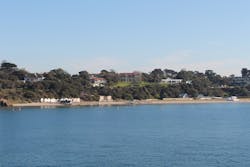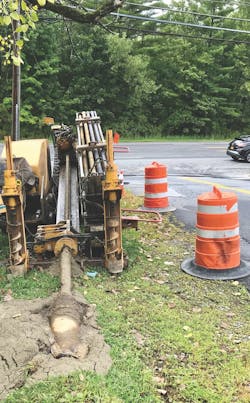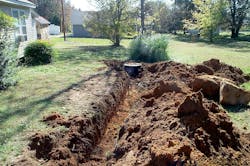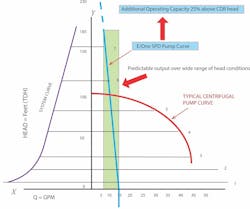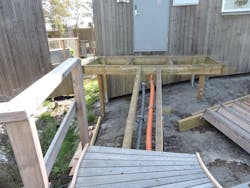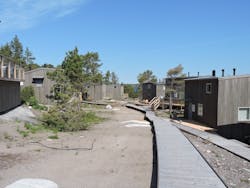Sewer Pumps: Pumps n' Pressure Sewer System
About the author:
Joseph Harmes is an independent writer. Harmes can be reached at [email protected].
Even a construction project like the world’s largest ethane steam cracker — a multi-billion-dollar state-of-the-art facility in southeast Texas — begins with every builder’s prerequisite: utilities. Indeed, the project’s first permit last summer was for wastewater in order to erect offices and warehouses.
Located a few miles from the Gulf of Mexico, the fertile but flat, sandy land with high water tables and infrequent storm surge (in 2017 Hurricane Harvey made landfall about 21 miles to the northeast) previously was hospitable to sorghum crops, but rotating to sewers would be challenging.
A heavy gravity sewer could sag in the unstable soil, crack, leak into groundwater and flood from infiltration. It might need a downgrade of 50 feet or more and probably expensive, time-consuming dewatering. Plus, it would require numerous lift stations running 24/7 and daily maintenance inspections. Additional conduits could be needed to divert storm water to reduce flows at the wastewater treatment plant — an aerial mock-up locates three storm water outfalls on the plant’s peripheries.
The consortium behind the facility possesses the capital and resources to build any sewer to any specs but preferred a faster, cheaper and technologically advanced alternative, namely the All-Terrain Sewer (ATS) manufactured by Environment One Corp. (E/One), whose grinder stations are anchored by 1 hp semi-positive displacement (SPD) pumps, which enable complex pressure sewer system designs because of their nearly vertical pump curve and the resulting predictable flow.
The company diagramed the system and E/One contributed station sizing, drawings, submittals, installation, and startup in addition to the customization of the stations, panels and flow rates. At present, the plans incorporate 11 grinder stations individually housing one, two, three or four pumps each. The system is supervisory control and data acquisition (SCADA) ready for monitoring from phones, tablets or laptops.
Three more duplex (two-pump) stations will service an onsite vendor and a 152-acre rail facility.
1 HP Muscle
The project is not the biggest in the history of the ATS, generically called a pressure sewer, but it demonstrates a quantum leap in the acceptance of pump-powered sewers pioneered by the Niskayuna, New York-based company in 1969. It also indicates a breakthrough beyond the residential construction and small- and large-scale septic-to-sewer conversions with which grinder pumps frequently are associated. If that was perceived as the pinnacle for sewer of pumps and 2-inch to 4-inch PVC pipes, it has been vanquished.
Every pressure sewer — and the sector counts many competitors — begins with a grinder pump station which has a tank about the size of a dishwasher that is buried in the ground, its lid easily camouflaged with minor landscaping. Inside, the pump is the primary component.
Often budgeted at half the cost of gravity, waste is blended into a fine slurry before a pump propels wastewater through small-diameter, inflow-and-infiltration-free pressurized pipes buried just below the frost line to a force main or treatment plant. The robust torque of an SPD pump, for example, can transport wastewater more than 2 miles or even straight up 186 feet.
“All-terrain” means just that. A pump-powered sewer re-invents the land, following contours and rolling elevations with little environmental disruption. It is quickly installed with horizontal directional drilling (HDD) under any terrain whether sandy, swampy or impossible to penetrate Hawaiian lava and Texas limestone. HDD navigates sewer pipes below rivers and through high water tables (without de-watering). If roads are involved, traffic is not disrupted with closures.
Centrifugal or SPD Pumps
Every pressure sewer utilizes either centrifugal or SPD pumps. The SPD pump was designed specifically for pressure sewer applications with input from the ASCE steering committee and staff. It features a capacitor start, thermally protected motor registering 1,725 rpm and operates at 240 or 120-volt, 60 Hz, 1 phase.
Other grinder pump companies employ a diverse array of centrifugal pumps from assorted manufacturers of varying horsepower and design specs. Centrifugal technology dates to the 17th century and is common in settings from agriculture to petroleum. In many cases, the centrifugal’s acceptance for pressure sewers is due to its familiarity throughout the pump industry.
Debating the technical merits and theories of centrifugal vs. SPD pressure sewers probably is best left to civil engineers, but a few points are worth mentioning.
One of the main differences between the two types of pumps is their operating curves. The semi-positive displacement pump has a much steeper operating curve and will maintain a fairly constant flow from 9 gallons per minute (gpm) to 13 gpm over the range of pressure heads.
The flow from a centrifugal pump will vary from about 10 gpm up to 30 to 40 gpm depending on the system pressures. Also, for a single-phase motor, the highest pumping head on centrifugal pumps is about 95 feet, while the total dynamic head of a semi-positive displacement pump doubles that.
Centrifugal pumps are self-limiting in flow and pressure. They will reduce their flow rates and increase pressure as sewage volume increases. This sometimes leads to system overload if there are too many pumps on-line at the same time. If system failure occurs, flow almost halts.
The SPD relies on maintaining a constant, predictable pump output often cited as the foundation for proper hydraulic design. This allows the engineer to minimize retention time and pump wear while enabling deep scouring action at effective levels. If sewage volume increases, the SPD boosts its output pressure to support a steady pumping rate.
Pump Durability
Operations and maintenance (O&M) budgets for competing sewer systems are not cheap. A breach in a gravity sewer might take days to locate, then analyze and finally repair. Backyard septic systems might seem like a low-maintenance alternative but that is only because of the flush-and-forget mentality of the owners.
In reality, they should undergo annual inspections (about $250 to $400) and have the septage removed every five to eight years. Septage treatment requires a different process than merely hauling it to a wastewater treatment plant and most municipalities are unequipped to handle the amounts properly maintained septic tanks produce.
O&M expenses for routine use of SPD pumps are well-documented, in many locations for a decade or longer. The average mean time between service calls is eight to 10 years. If pumps fail, they can be hoisted from the housing by removing only a few screws from the lid and before they are cleaned, diagnosed and serviced by maintenance department employees or a distributor. One operator of SPD pumps remarked a unit they replaced, “had been in the ground for 28 years and never had any service performed on it.”
Creating Building Alternatives
Increasingly, builders and bureaucrats around the world are discovering that much of their scarce land is unsuited for fragile septic systems (a top groundwater polluter) or disruptive and pricey gravity.
In today’s hot real estate market, each square foot of vacant property becomes more valuable. A pressure sewer can unlock a parcel once orphaned by gravity’s cost or, many times, the prohibition of septic in certain locations.
For municipalities, pressure system expansion can be accomplished on a one house at a time basis without the need to install large collector lines premised on future expansion projects. Builders see upfront costs for sewer infrastructure greatly reduced as wastewater connections are installed when a lot is sold. And every lot, regardless of geographic location, can be sewered, thus increasing profits.
The inclusion of more than one pump in a grinder tank, varying well capacities and flexible designs and discharge rates allows engineers to apply an all-terrain sewer to applications far beyond the scope of single-family homes.
E/One modeling indicates that an SPD-driven grinder housing with two pumps can connect up to nine single-family homes (even 24 where codes allow and with the company’s consent). In more water intensive locations, a triplex (three-pump) unit can handle flows of up to 5,000 gallons per day (gpd). Capabilities of other manufacturers’ SPD pumps may vary.
When Hawaii’s iconic Waikiki Shell (“the place to see the stars, under the stars”) faced clogged restroom facilities and sewer lines, the amphitheater — which can accommodate almost 9,000 attendees — moved forward with a station housing four SPD pumps capable of flows of up to 7,000 gpd.
Beyond Residential Applications
While all-terrain sewers are graduating to acceptance by some of the world’s largest corporations, they are found on almost every continent and activated daily by millions of ordinary end-users. An all-terrain sewer can be an affordable alternative for small towns like Southside, Arkansas, or even north of the Arctic Circle in Scandinavia. Massive projects currently network 15,000 pumps in Australia’s Mornington Peninsula and all-terrain sewers soon will supplant thousands of failing septic systems in densely populated Suffolk County on Long Island in New York.
Over the decades, this technology has advanced to include an array of clients in the public and private sectors and has shown its ability to sewer interesting locales, including:
- Historical sites like Alcatraz (The Rock), Hoover Dam, George Washington’s boyhood home, Thomas Jefferson’s Monticello, the Ticonderoga and Antietam battlefields, Frank Lloyd Wright’s masterpiece Falling Water, and even Drottningholm Palace, home of Sweden’s Royal Family;
- Resorts like Costa Rica’s Peninsula Papagayo and Querencia in Baja California Sur, and Kohana’iki and Kona Village in Hawaii;
- Waterfronts, such as California’s surfing mecca Carpenteria, Martha’s Vineyard and the Florida Keys;
- Government installations, including a U.S. Customs station on the New York-Canada border and military bases in Key West and Hawaii;
- Industrial facilities, including a rocket testing facility, fast casual restaurant chains, car dealerships, a small airport, office complexes and shopping centers; and
- Multi-residential housing, ranging from apartments and condos to campgrounds, small hotels or a senior housing project.
A Pump’s “Smart” Future
The real potential for pumps and pressure wastewater networks is being elevated by telemetry. In some places, like Mornington Peninsula, the system already is evolving into smart or intelligent sewers as SCADA devices provide complete system visibility to maximize equipment functionality and operator efficiency. Operators of such sewers can monitor the status of connections at the toilet as well as outside the home. Whereas the flow and intake inside a “dumb” gravity sewer can only be measured, not controlled, all-terrain sewer techs can manipulate individual pumps or even grids to regulate flows and remove peak volumes from the network under normal conditions and intense storm events. This reduces pressure on a wastewater treatment plant because it evens out the peaks and drops. In some cases, diminished flows will permit operators to save money by downsizing transfer pump stations and treatment plants.
About the Author
Joseph Harmes
Joseph Harmes is an independent writer. Harmes can be reached at [email protected].
